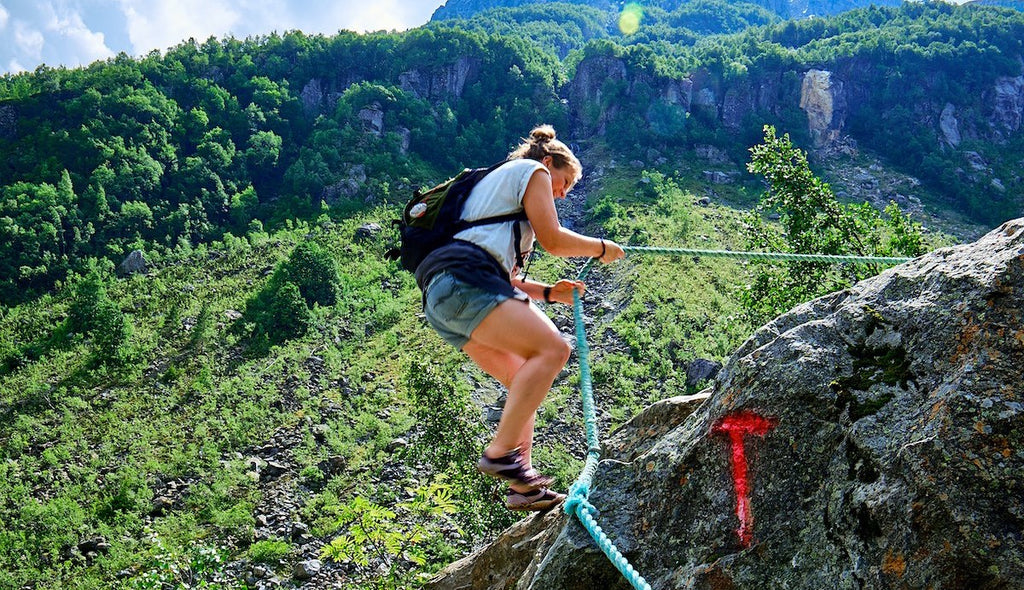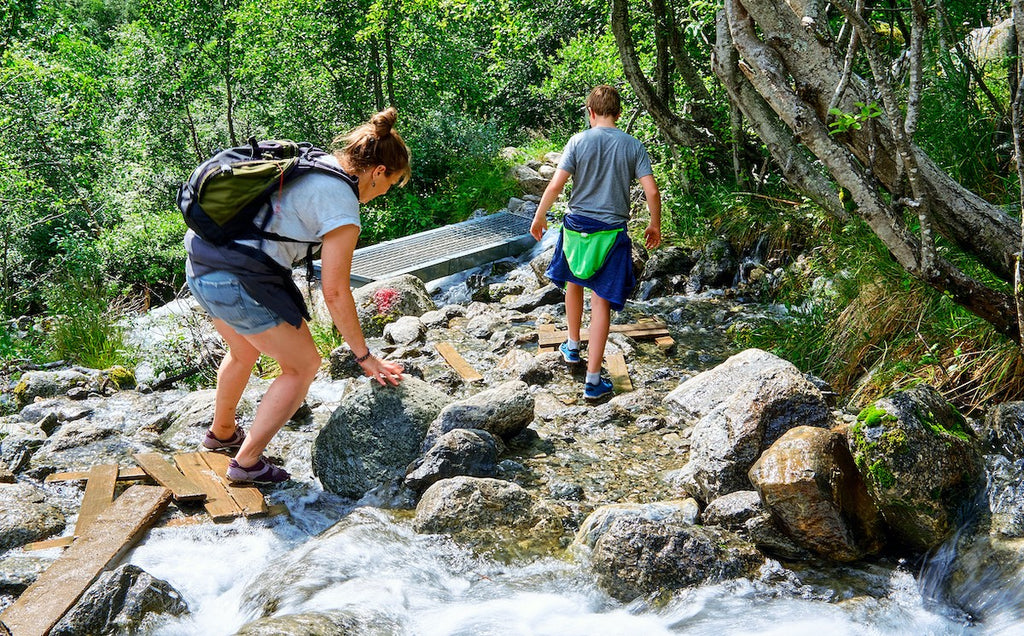
Do you love nature experiences beyond the ordinary, and can you live with the fact that a hike in some places requires you to climb up cliff sides, and in other places, pull yourself up on ropes? Then you should take a "hike" up to the glacier Folgefonna. You get very close to the large beautiful masses of ice, where you can feel the enormous forces nature sometimes contains. Norway provides fresh air, good exercise and breathtaking nature.
Let it be said right away, you need to be in relatively good shape to take the trip. As far as I remember, the Norwegians themselves call the trip a moderate hiking trip, but for us Danes who come from flat forest trails, the trip is more than just a walk. Not that you have to hold back, but there are a few passages that require a little effort to climb. So when after a few hours you get back to the foot of the mountain, with wet feet and sore thighs, then you are ready for a little breather.
It is very popular to make lists such as "5 things to see in Norway". Whether this is among the 5 most important sights is hard to say, but for us it was a great experience. It is not every day that you stand right next to a natural phenomenon, which you might well call a glacier. You may not be starstruck as you are when you stand on the edge of the pulpit and look down. But seeing the compressed blue ice towers up on top of the glacier is for us, as photographers and nature lovers, a huge experience.

Kig til toppen af Folgefonna gletscheren
Where is Folgefonna Glacier?
The glacier, or glacier, as it is called in Norwegian, is Norway's 3rd largest, and is located in the National Park Folgefonna, located in western Norway. The area is a good distance from Denmark, for a short holiday trip. We have a drive of approx. 12 hours from Birkerød, and up through Sweden.
You can get up to Folgefonna from several places. On the official page “Visit Norway” 3 options are described. Rullestad, Bergstø or Mosnes. We came to it from a 4th place namely Buer. If you drive towards Odda, which is located between Hardangerfjorden and Sandvevatnet, you drive towards Buer, and follow the signs to "Buarbreen", "Glacier" or Glacier - dear child has many names, and they use funny enough all of them, in their signage .
You then follow the road for approx. 8 km. until you come to a small parking lot where you park the car and take the rest of the way on foot. You can also enter the glacier from the opposite side, through Bondhusdalen. I honestly do not know if you can hike up to the top from that side, but there is a relatively long hike, through the valley, before you get to the foot of the mountain. So if you want to make it a little easier for yourself, drive to Bure, and park the car.

The start of the trip a long the stream with meltet ice
How hard is the hike to the Folgefonna glacier?
As written in the introduction, the Norwegians describe it as a moderate trip, but we have gradually been to a number of mountains in Norway, and as a Dane I would consider it a rather hard trip, with a lot of hardships along the way. In Denmark, we are not so used to having to climb up cliff sides when we are out on our Sunday trips, and that is what you have to do here.
As usual, the trip starts quietly and peacefully, with a good flat path, and as usual we are off in the clothes we are now walking and standing in, and as usual I have a jumping knee that teases. That is, shorts and flat shoes. Under dressed as usual - but we are getting used to it. The Norwegians themselves often come in full hiking uniforms, but they are also away every weekend. So you do not have to invest in expensive gear to reach the top, you might just get a little tired in the feet before you are down again.
You can easily manage the trip without bringing much provisions. We had a few bottles of water and some camera equipment. For the same reason, we shoot with Fuji's system cameras, as they take outstanding pictures and weigh incredibly little. I have previously hiked hard rides up off, with Canon SLR and a range of lenses on the back. That in itself can be tough.
So you have to be ready to give it gas for a few hours. You should not mind sticking your shoes in water, and you should not bring strollers or the like. It can also be a tough ride for young children, while for older children it is a great experience. We had our son of 14 with us up to Folgefonna, and he just enjoyed running ahead.
A little more about the actual trip up to the top
The trip up follows an official route, and it can be smart to use it, as there are ropes mounted here, you can pull yourself up from the rocks with, and built small bridges over the water when necessary. You start by walking along the river, where all the meltwater from the glacier runs down into the lake Sandvevatnet. Along the shore there are hundreds of small stone towers that people have built by stacking small stones on top of each other. It looks pretty nice, and in fact one of our best selling posters, just a small stone tower, is photographed here on the shore.
The flat landscape naturally stops quite quickly, after which the terrain becomes steeper and steeper. At first just a little steeper, but gradually you can feel that the percentage of increase rises in the air, and that the blood pumps a little harder when the steep cliffs have to be forced. Unlike many of the other hikes we have been on, you are not pushed out to vertical mountain sides, you hike and climb in a very safe environment. So it is only the physics you are challenged on - not the psyche.
Apart from right at the beginning, the trip is a mixture of slightly flatter pieces of land and gravel, areas with water (it was in 2015, when it rained constantly) and steep passages with smooth granite or high "granite stairs". It's really just about keeping the energy up, because all of a sudden you're on top. We spent about 1.5 hours to the top, but we also always stop many times along the way to take photos.

Agnete pulls up from the steep cliff sides

You can easily get your feet wet on the trip
Close to the top of Folgefonna
When you reach the top, it is not the top of the glacier you are standing on. It is a rocky plateau located below the glacier, from which you can enjoy the glacier up close. When I write close, there is a wide river with meltwater, between the plateau and the glacier, which means that you can not get completely and touch the ice. I do not know if the river can be climbed in between, but for us it was a huge experience just to stand so close to the large ice masses. In addition to the fact that a cold radiates from the large ice masses, you can simply feel and see the forces that the large mantle of "migrating" ice contains.
You can look up to the beautiful ice blue top, where the compressed ice towers up, as if it were made of the hardest pieces of granite leaning against each other. Further down towards the bottom of the glacier, the beautiful blue “rock to rock blanket” is replaced by a chaos of rocks and gravel that is pushed in front, around and on top of the ice. Everything helps to give the feeling of how small we humans are. A fantastic experience.
We had heard we would cry the first time we saw a whale, but we did not. We also did not cry when we were close to Folgefonna's blue ice masses, but there is no doubt that the experience is very high in the memory. Whether a glacier is something to see once in a lifetime, I also do not realize, I can just say that it is a nature experience far beyond the usual. We can recommend the trip to anyone who is hungry for beautiful and slightly unusual nature experiences, and as it is with such experiences, do not share the top with hundreds of other tourists.

The ice and rocks on Folgefonna form the most beautiful motifs

A bit of chaos where the ice pushes gravel, pebbles and pieces of rock in front of it

Descent in rainy weather is a smooth ride - so tread carefully and remember rainwear
PS: The trip down took place in the rain of piss' øs, which partly made the trip very slow down over the wet cliff sides, and partly very wet. Remember rainwear if there is a pull for rain, which can come very suddenly in the mountains.
If you are interested in taking a guided hike on top of the glacier, then it is also possible. Search Google to find out how.
Do you want more stories from Norway?

- We took the Prosecco route - Without touching a single drop of prosecco!
- Copenhagen - Italy, our first long trip in Europe in an electric car
- Hos PLAKATfar er vi eksperter i udsmykning af institutioner
- Guide to the many poster sizes and frame sizes
- Sådan kan plakater forvandle dit hjem - 10 tips fra PLAKATfar
- Travel guide from our trip to Båstnäs Car Cemetery or Ivan's Junk Yard
- Guide til ophængning af plakater og billeder
- Plakatfar udsmykker også institutioner
- Make your own picture wall
- Køb en ramme til din plakat og få gratis indramning
- Smart tip til at få store billeder, uden at betale en formue
- Color symbolism and the meaning of colors
- Travel guide from our hike to the Folgefonna Glacier
- Travel guide from our photo trip to the pulpit in Norway
- 5 bud på plakater, der hylder den danske sommer
- Prissammenligning af de billigste rammer til plakater og billeder
- Sådan sammensætter du let plakater og billeder
- Norge - et slaraffenland for naturelskere
- Old Stavanger - is it worth traveling for?
- Posters from Faroe Islands



